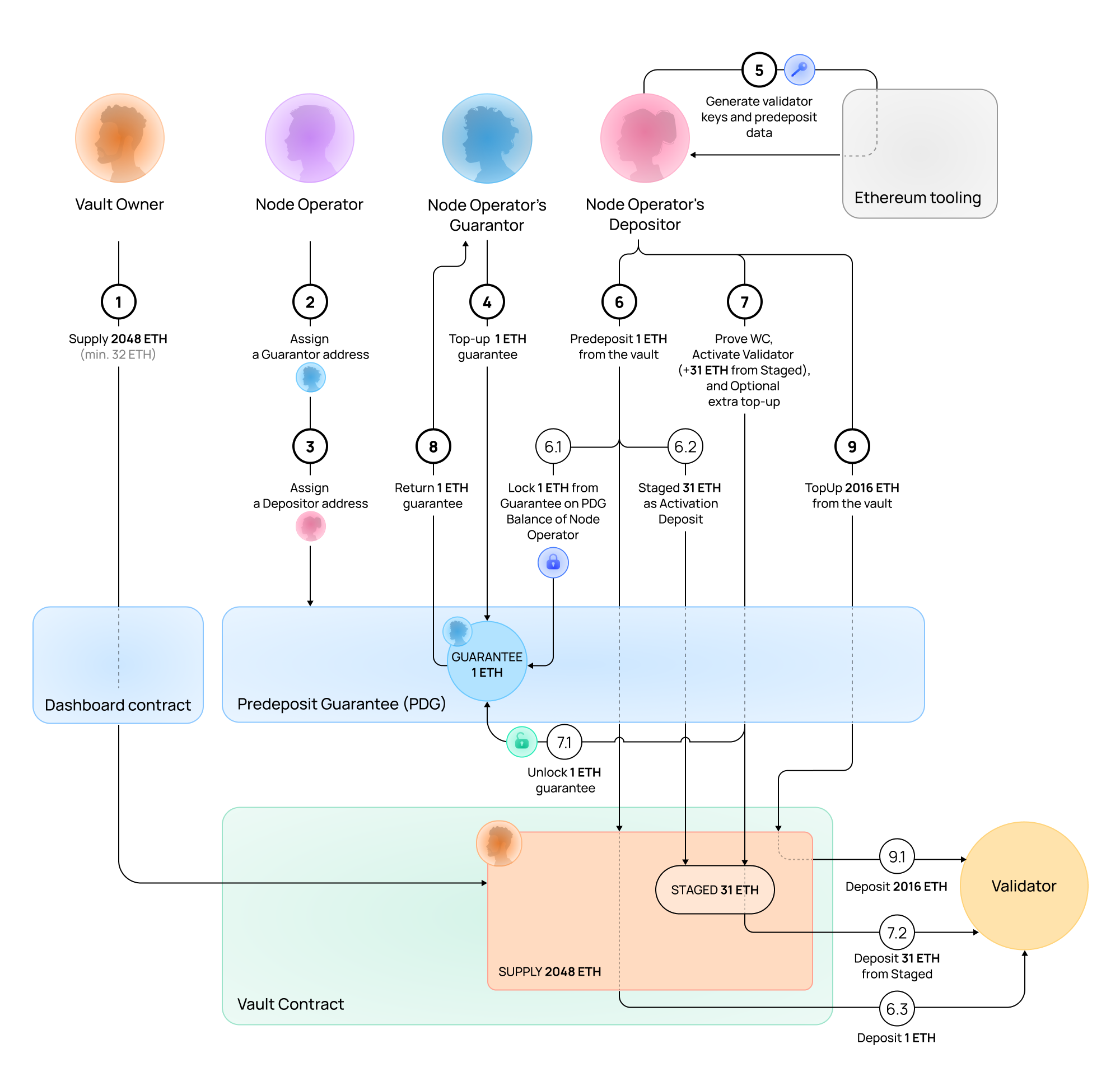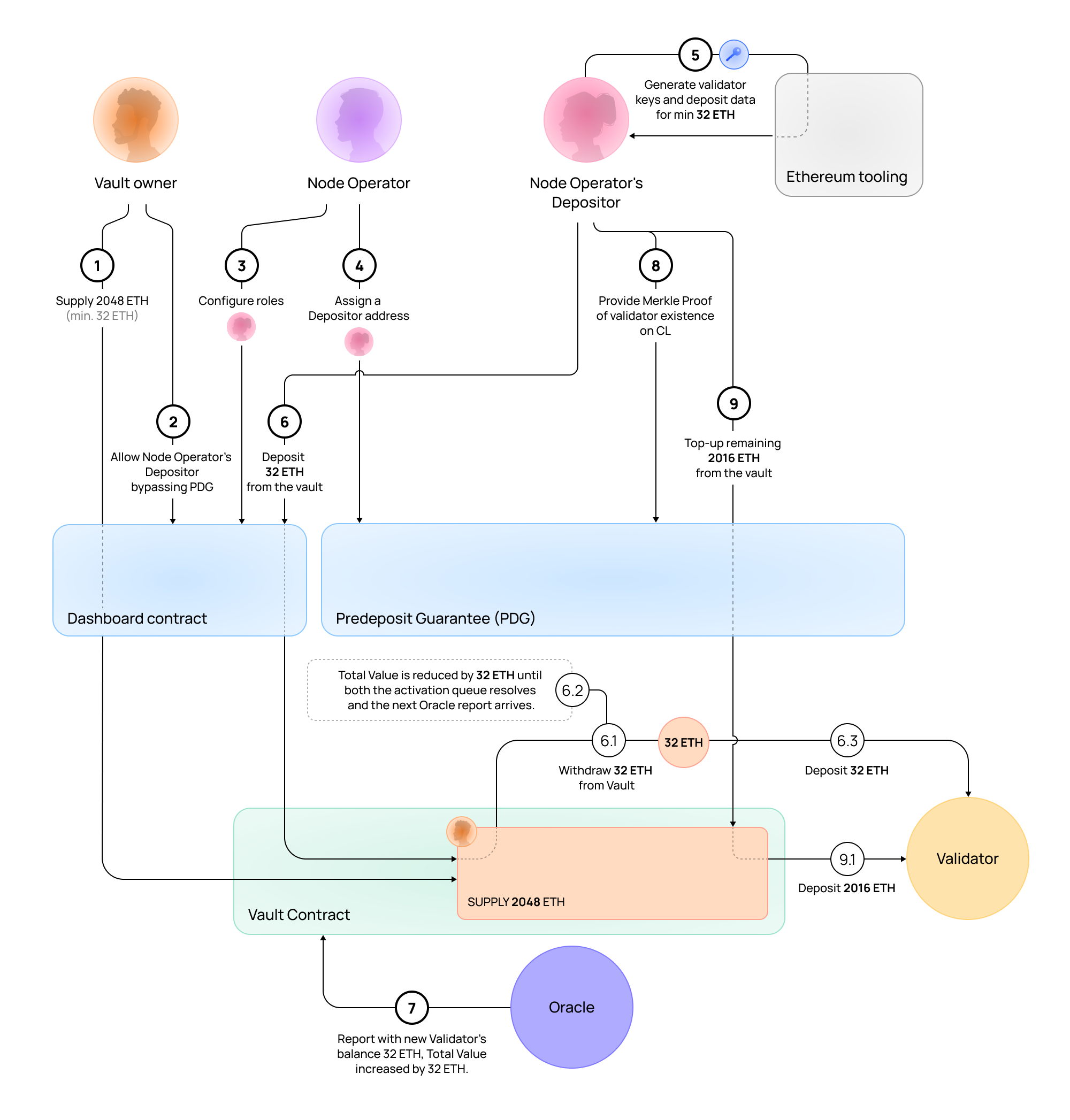Predeposit Guarantee
According to the updated V3 rollout plan, the Predeposit Guarantee (PDG) contract is now paused on the Hoodi Testnet and will also be paused on Mainnet during the soft-launch in late December 2025.
Phase 2 (Full Launch Mode), including the fully functional PDG, is expected in late January 2026.
This user guide explains how to use the Predeposit Guarantee contract as part of the stVaults staking infrastructure.
The Predeposit Guarantee (PDG) contract mitigates deposit frontrunning vulnerabilities outlined in LIP-5. It disincentivizes frontrunning by having the Node Operator post an economic guarantee of honest behavior, which is proven/disproven via EIP-4788. This mechanism is distinct from the Deposit Security Module used by Lido Core.
The PDG enables Node Operators to deposit validators using vault funds in a trustless manner.
stVaults are using 0x02-type withdrawal credentials for deposits.
Therefore stVaults can utilize large validators (depositing up to 2048 ETH per single validator without losing efficiency).
Resources
Deposit Data Generation
Node Operators should generate deposit data with the following specifications for stVaults:
- Withdrawal credentials:
0x02-typeformat pointing to the stVault address (0x02+ 30 bytes of zeros + stVault address) - Amount for predeposit: 1 ETH (for the initial predeposit phase)
Additional deposits may be made in any amount up to the validator’s remaining balance. Deposit data is only necessary for validator proof and is not needed for subsequent top-ups.
You can use this tool for generating deposit data: Depositor
Use cases
Full-cycle trustless path through PDG
Advantages:
- The PDG enables a non-custodial depositing mechanism by using a Node Operator's (or its guarantor's) provided ether guarantee as collateral.
- Separation of ether funds between the Vault Owner and the Node Operator.
- This approach enables spawning validators without impacting key stVault metrics: Total Value, stETH minting capacity, Health Factor, etc.

Steps:
-
The Vault Owner supplies 2048 ETH (minimum 32 ETH required to activate a validator) to the vault.
- Method called:
Dashboard.fund()with ETH transfer (payable). - Caller must have the
FUND_ROLErole.
- Method called:
-
(Optional) The Node Operator assigns a
Guarantoraddress that will provide a 1 ETH guarantee. This allows the Node Operator to delegate guarantees to an arbitrary hot account while keeping the Node Operator private key safe in cold storage.- The default
Guarantoris the Node Operator. - Method called:
PredepositGuarantee.setNodeOperatorGuarantor(newGuarantor). - Caller must be the
StakingVault.nodeOperatoraddress.
- The default
-
(Optional) The Node Operator assigns a
Depositoraddress that will deposit and top up validators with ETH from the stVault balance. This allows the Node Operator to delegate deposits to an arbitrary hot account while keeping the Node Operator private key safe in cold storage.- The default
Depositoris the Node Operator. - Method called:
PredepositGuarantee.setNodeOperatorDepositor(newDepositor). - Caller must be the
StakingVault.nodeOperatoraddress.
- The default
-
The
Guarantortops up 1 ETH to the PDG contract, specifying the Node Operator's address. This serves as the predeposit guarantee collateral.- Method called:
PredepositGuarantee.topUpNodeOperatorBalance(nodeOperator)with ETH transfer. - Caller must be specified as the
Guarantorin the PredepositGuarantee contract.
- Method called:
-
The
Depositorgenerates validator keys and predeposit data. -
The
Depositorpredeposits 1 ETH from the vault balance to the validator via the PDG contract.- Method called:
PredepositGuarantee.predeposit(stakingVault, deposits, depositsY). - Caller must be the
Depositorin the PredepositGuarantee contract.
As a result:
- 6.1. The PDG locks 1 ETH from the Node Operator's guarantee collateral in the PDG.
- 6.2. 31 ETH on the stVault balance is staged as Activation Deposit (expecting to be deposited to the validator later).
- 6.3. 1 ETH is deposited to validator.
- Method called:
-
The
Depositorproves the validator's appearance on the Consensus Layer to the PDG contract with the withdrawal credentials corresponding to the stVault's address, activates the validator, and (optionally) performs an extra top-up.- Method called:
PredepositGuarantee.proveWCActivateAndTopUpValidators(witness, amounts). - Caller must be the
Depositorin the PredepositGuarantee contract.
As a result:
- 7.1. Upon successful verification, 1 ETH of the Node Operator's guarantee collateral is unlocked from the PDG balance — making it available for withdrawal or reuse for the next validator predeposit.
- 7.2. 31 ETH is deposited to validator from the amount that was Staged on the stVault balance.
- 7.3 (Optional) extra ETH is deposited on validator, if extra top up was selected.
- Method called:
-
(Optional) The
Guarantorwithdraws the 1 ETH from the PDG contract or retains it for reuse with future validators.
Method called:PredepositGuarantee.withdrawNodeOperatorBalance(nodeOperator, amount, recipient).- Caller must be the
Guarantorin the PredepositGuarantee contract.
- Caller must be the
-
The
Depositormakes a top-up deposit of the remaining 2016 ETH from the vault balance to the validator through the PDG.- Method called:
PredepositGuarantee.topUpExistingValidators(Array topUps). - Caller must be the
Depositorin the PredepositGuarantee contract.
As a result:
- 9.1. 2016 ETH is deposited on validator.
- Method called:
PDG shortcut
This mechanism allows one to bypass the predeposit step, enabling a one-transaction direct deposit of up to 2048 ETH (as per EIP-7251) to the validator without using PDG. The validator can be linked to the vault after the deposit by submitting proof through the PDG contract.
Advantages:
- Fewer actions, lower gas fees. It's possible to deposit 2048 ETH in one transaction.
- No mandatory requirement to prove validators if there are no plans to use top-up further.
Cons:
- This approach requires mutual off-chain trust between the Node Operator and the Vault Owner.
- This mechanism reduces stVault Total Value until validator activation as reported by the oracle.
- Requires unlocked ETH on the stVault Balance to deposit (i.e. not possible when utilization ratio is close to 100%).

Steps:
-
The Vault Owner supplies ETH to the vault but does not mint against it.
- Method called:
Dashboard.fund()with ETH transfer (payable). - Caller must have the
FUND_ROLErole (or be its admin).
- Method called:
-
The Vault Owner gives the Node Operator an explicit permission to bypass PDG by setting the appropriate PDG policy.
- Method called:
Dashboard.setPDGPolicy(PDGPolicy). - Caller must have the
DEFAULT_ADMIN_ROLErole (or be its admin).
PDG Policies:
STRICT(Default): deposits require the full PDG process.ALLOW_PROVE: allows proving unknown validators to PDG (but not unguaranteed deposits).ALLOW_DEPOSIT_AND_PROVE: allows both unguaranteed deposits (bypassing the predeposit requirement) and proving unknown validators.
- Method called:
-
(Optional) The Node Operator Manager grants the necessary roles to the address that will perform unguaranteed deposits and proving. By default, the Node Operator Manager can perform unguaranteed deposits. In this guide, we assume both roles are granted to the same address referred to as
Depositor.- Method called:
Dashboard.grantRole(role, account)for each role. - Caller must have the
NODE_OPERATOR_MANAGER_ROLErole. - Roles to grant:
NODE_OPERATOR_UNGUARANTEED_DEPOSIT_ROLE— allows callingunguaranteedDepositToBeaconChain()NODE_OPERATOR_PROVE_UNKNOWN_VALIDATOR_ROLE— allows callingproveUnknownValidatorsToPDG()
- Method called:
-
(Optional) The Node Operator assigns a
Depositoraddress in the PDG contract that will be authorized to top up validators via PDG after they are proven. By default, the Node Operator is theDepositor.- Method called:
PredepositGuarantee.setNodeOperatorDepositor(newDepositor). - Caller must be the Node Operator address (as registered in the StakingVault via
nodeOperator()).
- Method called:
-
The
Depositorgenerates validator keys and deposit data with:- Withdrawal credentials in
0x02-typeformat pointing to the stVault address (StakingVault.withdrawalCredentials()). - Deposit amount must not bring the validator balance over 2048 ETH.
- Withdrawal credentials in
-
The
Depositorperforms a deposit in the specified amount from the vault balance to the validator via the Dashboard contract.- Method called:
Dashboard.unguaranteedDepositToBeaconChain(deposits). - Caller must have the
NODE_OPERATOR_UNGUARANTEED_DEPOSIT_ROLErole (or be its admin).
As a result:
- 6.1. ETH is withdrawn from the stVault's withdrawable balance.
- 6.2. stVault Total Value is reduced by the deposit amount until the validator appears in the Beacon Chain state AND is included in a subsequent Oracle report.
- 6.3. ETH is deposited to the validator via the Ethereum Deposit Contract.
- Method called:
-
The Oracle report includes the new validator's balance; stVault Total Value increases by the deposit amount.
-
(Optional) The
Depositorproves the validator's appearance on the Consensus Layer to enable future top-ups via PDG. If the validator has max effective balance (2048 ETH), there is no need to prove it, as it cannot be topped up further.- Method called:
Dashboard.proveUnknownValidatorsToPDG(witnesses). - Caller must have the
NODE_OPERATOR_PROVE_UNKNOWN_VALIDATOR_ROLErole (or be its admin).
As a result:
- 8.1. The validator transitions from
NONEtoACTIVATEDstage in PDG. - 8.2. The validator is now registered in PDG and can receive top-ups via
topUpExistingValidators().
- Method called:
-
(Optional) The
Depositormakes a top-up deposit from the vault balance to the validator through PDG.- Method called:
PredepositGuarantee.topUpExistingValidators(topUps). - Caller must be the address set as
Depositorin the PDG contract. - Top-up amount must not bring the validator balance over 2048 ETH.
As a result:
- 9.1. The specified ETH amount is deposited to the validator from the stVault balance.
- Method called:
Feel free to drop your thoughts about PDG and Lido V3 through this simple form.